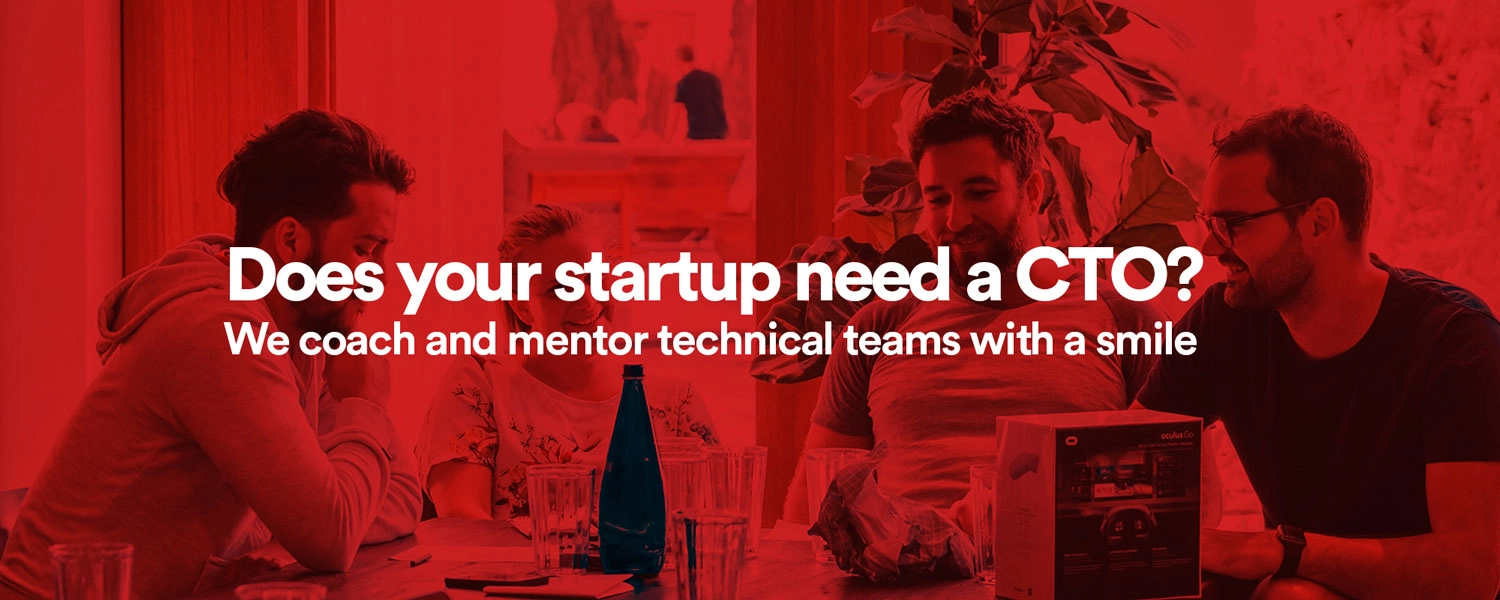Does your team need Fractional CTO services?
As your software development team begins to grow, you might feel the need to promote your technical cofounder to the role of Chief Technology Officer. That’s often a mistake. There are many different skills a CTO needs depending on the size of the company, especially in SaaS. Early on, it’s unlikely to require full-time dedication.
A software CTO becomes multifaceted real quick
A “normal” CTO is typically responsible for creating the overall strategy for the startup, and they are in charge of drawing the technical and infrastructural guidelines of the company. A CTO must be multifaceted and should have plenty of experience in the field.
This creative profile is an expensive but invaluable member of the team, especially when the startup is growing. You can imagine that a well-rounded and senior profile comes with a high cost. And not all startups can afford this. Some freelance CTOs charge upwards of €1000 per day.
Enter the fractional CTO in your technical leadership team. In essence, it’s a part-time CTO, someone that can provide strategic advice on technical topics.
When you are a thrifty and scrappy startup, you might have a searing problem that demands attention. It doesn’t make sense to hire someone full-time to help solve that problem. Instead, a fractional CTO can help get you moving in the right direction again.
What types of problems can part time ctos or fractional CTOs resolve?
CTOs are best suited to deal with strategic issues. They often have deep expertise in strategic thinking and apply methodologies such as Roger L. Martin’s Playing to Win framework or lessons from Michael Porter’s definitive work, Competitive Strategy. Fractional CTOs can take on many of the responsibilities of a full-time in-house CTO. Here are some topics we regularly manage:
- Rewrite vs refactor — As technology ages, engineers often want to rebuild a product from scratch. This desire causes big rifts in many teams. Sometimes an outside perspective is needed. We usually end up with the same answer though.
- Build vs buy vs partner — As the technical landscape evolves, some approaches and tactics are no longer viable. Then the team must respond. Choosing the appropriate path forward can be difficult.
- Roadmap challenges — What should we build next and in which order? Teams need a plan, a plan that takes one step at a time. When product and engineering can’t agree, it’s time to review the priorities and vision. Learn how to communicate your roadmap to VCs properly.
- Investment is needed — It might seem counterintuitive, but if the company needs to raise money, you might need to engage a fractional CTO or at least enjoy the benefits of technology leadership consulting. They can help you understand what the strengths and weaknesses of the organization are and how to frame those to investors. We see this a lot during our due diligence audits.
- Muster reinforcements — When your engineering team needs an upgrade rely on deep expertise to make the right hiring decisions. We find many teams filled with “senior” profiles or staff engineers that turn out to be not so senior. Bringing in an external technical partner allows you to have a clear picture on how your team’s talent compares to other companies. Or you could consider coaching services for your technical leadership team.
- Budget revisions — Budgeting is hard. Cuts are harder. Whether it’s time to grow or shrink the team, you need an accurate picture of costs ranging from personnel to infrastructure. Senior engineering leadership can help make your projections more accurate. Keep in mind, by hiring a fractional CTO, you can already save money as well.
- Scaling issues — A lot of teams ambitiously size their infrastructure, then the customers don’t show up. If it’s time to rethink the architecture and related infrastructure, a CTO can provide good insight into how the team can prepare for growth but in a cost effective way.
- Contract negotiations — I hope your partnerships are fruitful and that you continue them. But are you getting the best bang for your buck? Negotiations can be challenging, especially when dealing with the nuance of technical contracts. A fractional CTO, as an outsider, might make this process easier.
- GDPR questions — Privacy is always increasing in importance. It can be confusing to understand the legal obligations for the business, how to handle GDPR data deletion requests, and when a data protection officer (DPO) is needed.
- Open source integration — Teams must ensure they are abiding by open source licensing requirements. And if your team wants to open source some of the technology they’ve built — something we encourage others to do — then seniority is needed to avoid some common mistakes.
You’ll notice that these topics are largely strategic. For tactical or operational advice, consider engaging a VP of Engineering or Engineering Manager. Folks at this level can help optimize the way teams deliver value, from improving quality with code reviews or test-driven development practices to creating a psychologically safe environment, the key trait of high-performance teams.

Benefits of having a fractional CTO in your startup
If you can’t afford a full-time CTO, you can still benefit from a fractional CTO. Here are some of the main advantages:
- Expertise and experience: A fractional CTO brings a wealth of technical expertise and experience to your startup. This can be especially valuable if you are a non-technical founder or if your team lacks experience in certain areas of technology. The fractional CTO has typically seen similar challenges at different startups, making it easier to find the path toward success.
- Strategic guidance: A fractional CTO helps you develop a technology roadmap and strategy for your startup. They can help you make informed decisions about the technologies to invest in and how to allocate resources. They will also align product development with business goals.
- Improved efficiency: A fractional CTO streamlines your technology processes and systems, leading to improved efficiency and productivity.
- Cost savings: Hiring a full-time CTO can be expensive, especially for a startup. A fractional CTO allows you to access the expertise and experience of a CTO on a part-time basis, which can be more cost-effective.
- Outside perspective: It’s often a good idea to have an outsider pair of eyes in your business. They can clearly evaluate and question staff performance and technology choices without carrying any historic burden.
- Flexibility: A fractional CTO can be hired on a project-by-project basis, which allows you to have the flexibility to scale up or down your technology resources as needed.
What types of skills should a part-time CTO have?
Of course, each CTO has their own strengths and weaknesses, so finding one with the proper skills is important. Depending on the problem you are trying to resolve, you’ll need a CTO with different backgrounds. Check that they have domain expertise for your specific challenges.
All fractional CTOs in the SaaS ecosystem should have these skills
Most importantly, whoever you engage needs to be a good communicator and storyteller. Their job is to analyze a situation and translate it into layperson terms. Make sure the person you work with is a good writer.
Since they’ll be interacting with your executive team — and maybe even investors — they need good stakeholder management skills. It can be a challenge to work transparently but still set the correct expectations, especially when some people have big demands.
The main skills of a fractional CTO in small companies
Other skills depend on the size of the company. For smaller companies, the responsibility is usually hands-on. You are looking for someone that regularly codes and reviews code. They deeply understand your technology stack and its limitations. They can challenge you on the decisions you’ve already made.
The main skills of a fractional CTO in scale-ups
Once your company has found product-market fit and is in the scale-up phase , the responsibilities shift a bit. It’s likely they’ll need to provide insight into team management and risk mitigation. The technical skills don’t matter as much. You’ll also find folks at this level have a deeper understanding of product needs.
The main skills of a fractional CTO in enterprises & stable companies
Finally, if you are approaching the enterprise or stable company size, the focus greatly shifts towards topics such as privacy (GDPR), security (intrusion detection and defensive posture), and exploring the technical horizon (machine learning and web3 applications).
Regardless of company size, the CTOs chief role is to work with the business to define the vision and check what’s technically possible (or not). They need to then guide internal teams to make the best decisions possible so that individual contributors efficiently build a product, one that truly solves customer problems.
- Read how we help SaaS CTOs with our mentoring and coaching traject
We are madewithlove and we love helping startups
How can you hire a fractional CTO?
Step 1: source. Step 2: evaluate. Step 3: hire. Easy peasy. Right? And don't do it fast. Fortunately, we put together a guide on how to hire a CTO. The same rules apply for a fractional CTO.
Step 1: Source CTO profiles
When it comes to sourcing, rely on your existing network to get the word out. You can also use an executive search agency that specializes in technology to help you find the right person. Make sure you publish the advert on LinkedIn and use an application tracking system (ATS) to help you organize candidates.
Step 2: Evaluate the candidates
After filtering resumes based on the skills of a Free Range Manager, you’ll want to propose a technical challenge. This challenge is not a whiteboard coding exercise but instead a way to test the most important capabilities you need.
For instance, if you are hiring a CTO to resolve a roadmap dispute, you pose a similar challenge. The challenge should be clearly fictional but related:
You’ve just joined a small grocer who is focused on connecting healthy young people to small farms. They’ve been struggling with their existing infrastructure and are considering a switch to a new cloud provider. At the same time, the product team wants to create the next big feature: personalized newsletters. How do you resolve this issue?
Step 3: Hire the best fit as a fractional CTO
Making the final decision can be a challenge, especially if you aren’t technical yourself. Fortunately, madewithlove can help you. Not only do we offer CTO as a service, but we can also help you find a CTO through our recruiting service.

What does a fractional CTO cost?
What are the rates of a Fractional CTO?
It’s hard to pin down exact numbers as the rates of fractional CTOs vary a lot, depending on experience, location, specific skills and (sadly), the urgency of the clients’ needs. Also consider the length of their engagement and scope of responsibilities before creating your budget.
Generally, fractional CTOs are hired on an hourly or project basis, rather than a salary basis. Hourly rates for fractional CTOs can range from €100 to €300 per hour, depending on the CTO’s level of expertise and the specific requirements of the project.
For a longer-term engagement, the CTO may be hired on a retainer basis, with a fixed number of hours per month or quarter. In this case, the cost will depend on the number of hours included in the retainer and the hourly rate of the CTO.
It’s worth noting that the cost of a fractional CTO will generally be lower than the cost of hiring a full-time CTO, especially for startups that may not have the resources to hire a full-time CTO.
What makes Andreas Creten a successful CTO? (Dutch)
Should a fractional CTO be on-site or can they be remote?
After the pandemic, most companies should be able to work with a remote CTO, especially if they are fractional. At the executive level, it’s important that individuals have time to deeply focus on strategic matters instead of sitting in traffic during a commute.
And if you require your CTO to be on-site, this is a sign that you need to invest more in digitization and modernization of your software development team, something that a fractional CTO can help you plan and deliver.
Interim CTO vs fractional CTO vs part-time CTO
Interim CTOs, fractional CTOs, and part-time CTOs are all types of CTOs who work on a part-time basis rather than a full-time basis. But what’s in a name? A title is just a title and you can call your CTO helpforce however you want. There are however some small differences and nuances between the jobs, so we advise you to look at the person you intend to work with instead of their role.
Overall, the main difference between these three types of CTOs is the scope and duration of their involvement in the company.
Interim CTOs: An interim CTO or transitional CTO is someone who is hired on a temporary basis to fill a gap in leadership while a permanent CTO is being recruited or while the company is undergoing a transition. Interim CTOs are typically brought in for a specific project or for a limited period of time.
Fractional CTOs: A fractional CTO is a CTO who works for a company on a part-time basis, typically providing strategic guidance and direction for the company’s technology operations. Fractional CTOs are usually hired on a long-term basis and work closely with the rest of the leadership team to develop and implement a technology roadmap. However, their role and responsibilities change with the growth of the company.
Part-time CTOs: A part-time CTO is a Chief Technical Officer who, obviously, works for a company on a part-time basis but is not necessarily involved in strategic decision-making. Part-time CTOs may focus more on operational tasks and may not have as much involvement in the overall direction of the company’s technology strategy. We recommend that operationally focused experts take up this responsibility instead.
When to hire a Fractional CTO?
Diving into the world of fractional CTO services reveals several key moments where this approach shines brilliantly. It's always a hard decision to make: when to hire a fractional CTO, and when will they be beneficial in your growing startup?
- When budgets are tight: For those navigating the complexities of tech leadership on a shoestring budget, a fractional CTO emerges as an astute choice, blending senior expertise with cost efficiency.
- In the wake of a CTO departure: Facing the abrupt exit of a full-time CTO? A fractional CTO can seamlessly bridge the gap, ensuring continuity without the delay of traditional recruitment, ready to hit the ground running. We've seen this a lot with our clients, and it's really helpful to temporarily take the technical lead and help the company with hiring a new CTO for the future.
- When you want to promote your technical lead into the CTO: Nurturing in-house talent is a commendable strategy, yet the transition from technical lead to a CTO role is a significant leap. Temporary CTO services can mentor your rising star, offering a scaffold of senior leadership experience and strategic insight. This ensures a smooth evolution in their new role, empowering them to confidently take the helm of your tech vision and leadership
- When vision exceeds technical grasp: Picture this – you're eyeing an ambitious tech upgrade, like weaving sophisticated payment solutions into your digital storefront, but your team's expertise falls short. Enter the fractional CTO, your ace in digital innovation, ready to transform vision into reality with their specialized skill set.
- For precise leadership needs: Whether it's steering a project with pinpoint precision or infusing your team with strategic vision on an as-needed basis, a fractional CTO integrates into your workflow, embodying the essence of flexibility and focus.
We really think these terms are cut from the same cloth. Regardless of the title, it’s important to get proper insight and make the correct high-level decisions. The most expensive thing you can do is focus on the wrong problem. If you are struggling with a technical vision or technical strategy, reach out! We’re here to help.

Reading tips on CTOs in startups and scale-ups
- The benefits of CTO as a Service
- How a CTO builds a team
- CTO Soundboard - Coaching tech leaders
- How a CTO makes technical decisions
- The first days as a fire-fighting CTO
- Does your CTO or Startup need help with CTO Coaching or mentoring?
- How to communicate your roadmap to Investors and VCs
- What are staff engineers and why are they useful?










Member discussion